 The Ultimate BONSAI HANDBOOK The Complete Guide for Beginners Yukio Hirose
The Ultimate BONSAI HANDBOOK The Complete Guide for Beginners Yukio Hirose 
 INTRODUCTION Bonsai is a part of Japanese culture that has long been in the worlds spotlight. I discovered bonsai when I was a junior in college. After finishing up a karate training workshop in Kochi Prefecture, I headed over to the Osaka World Expo (1970). When I first laid eyes on authentic bonsai, I was moved by their beauty and decided then and there to make bonsai my career. My family already had a nursery and a decent landscape at home, so while I was helping out with the family business, I was fostering bonsai. Eventually, I started selling bonsai as well.
INTRODUCTION Bonsai is a part of Japanese culture that has long been in the worlds spotlight. I discovered bonsai when I was a junior in college. After finishing up a karate training workshop in Kochi Prefecture, I headed over to the Osaka World Expo (1970). When I first laid eyes on authentic bonsai, I was moved by their beauty and decided then and there to make bonsai my career. My family already had a nursery and a decent landscape at home, so while I was helping out with the family business, I was fostering bonsai. Eventually, I started selling bonsai as well.
Ive reached this point in my career without having any formal training. I just imitate what I see. Those whose knowledge exceeds mine are my masters. Learn a little something each day. Thats how I decided to go about it, and its how I amassed my knowledge of bonsai and my skill in growing them. I found myself completely absorbed by the world of bonsai, and by this wonderful process of taming miniature trees on the palms of my hands.
Before I knew it, half a century had gone by. Miniature bonsai dont require high quality, aged materials. You can start with materials you have at hand, cutting, dividing, pruning, and shaping with wire. With a little determination, you can create your own piece. For beginners whove just opened the door to the world of bonsai, this book will guide you through it, step by step, with visuals to help you along the way. Start by observing and imitating.
Once you become fairly well acquainted with bonsai, you can start experimenting with your own ideas. In recent years, raising bonsai has become a hobby for people of all ages, in many parts of the world. I hope that this book will help add to the number of bonsai practitioners, and spread the love of bonsai. Yukio Hirose CHAPTER 1 THE BASICS
CHAPTER 1 THE BASICS 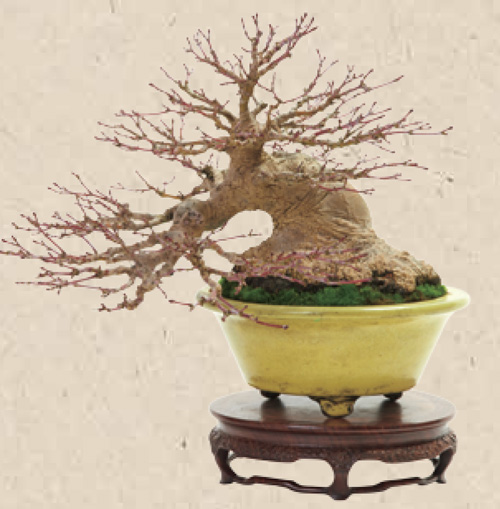 DIFFERENCES BETWEEN BONSAI AND GARDENING Even though the same plant can be used in both container garderning and bonsai, the goal, technique, container and result will be different. In bonsai, the role of the pot is perhaps more complex than it is for container gardening. The pot is shallow and must harmonize with the plants gender attributes. The pots size should be proportionate to the trees height, trunk width, root system and foliage.
DIFFERENCES BETWEEN BONSAI AND GARDENING Even though the same plant can be used in both container garderning and bonsai, the goal, technique, container and result will be different. In bonsai, the role of the pot is perhaps more complex than it is for container gardening. The pot is shallow and must harmonize with the plants gender attributes. The pots size should be proportionate to the trees height, trunk width, root system and foliage.
Shape is another point of difference between container gardening and bonsai. In gardening, the plants are deeper-rooted, grow upwards, and spread out in a natural dome. Bonsai, on the other hand, utilizes various techniques to train the trunk, branches and roots to replicate the form and features of an aged tree. Even the tiniest bonsai inspires a certain reverence. When you look at a bonsai, it should seem as if it has lived for centuries. 
 MEMO Bonsai are classified by the height of the tree Large-size (also called Imperial) bonsai if the height is taller than 23 in (60 cm).
MEMO Bonsai are classified by the height of the tree Large-size (also called Imperial) bonsai if the height is taller than 23 in (60 cm). 
 MEMO Bonsai are classified by the height of the tree Large-size (also called Imperial) bonsai if the height is taller than 23 in (60 cm).
MEMO Bonsai are classified by the height of the tree Large-size (also called Imperial) bonsai if the height is taller than 23 in (60 cm).
Medium-size bonsai if the height is between 8 and 15 in (20 and 40 cm). Small-size bonsai if the height is lower than 8 in (20 cm).
*They are usually about the size of a hands palm. This book will introduce small-size bonsai. Bean-size bonsai if the height is lower than 4 in (10 cm).  WHAT TO OBSERVE IN A BONSAI The following tips can help you better observe and appreciate bonsai. Your first look should be up close; then, slowly distance yourself from the tree until you can see it in its entirety and context.
WHAT TO OBSERVE IN A BONSAI The following tips can help you better observe and appreciate bonsai. Your first look should be up close; then, slowly distance yourself from the tree until you can see it in its entirety and context.
Going to exhibitions will give you an excellent opportunity to observe a wide variety of bonsai. These pointers will help you determine if each part of the bonsai is in good shape: 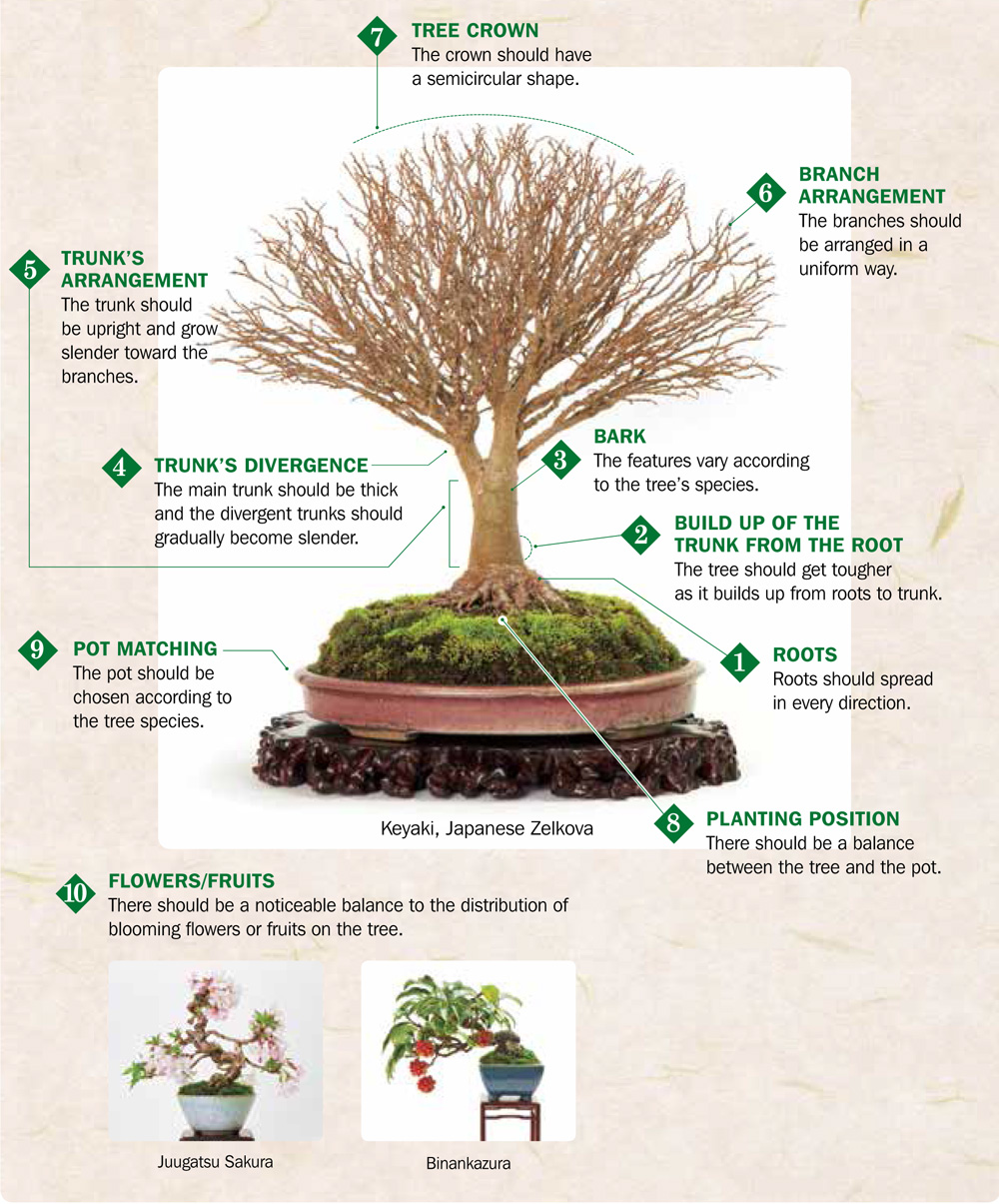 TYPES OF BONSAI Among the types of bonsai, other than Shouhaku, Zouki, Hanamono and Mimono, there are also Kusamono, which are planted alongside other bonsai. Shouhaku Starting from Matsu, Zugi, Hinoki and other evergreen coniferous trees are called Shohaku. Overflowing with life energy, they have the charm that comes with longevity, surfaces that attest to many years of living. Among them, Matsu are often used as New Year decorations, due to their color, which is said to bring luck (pictured here is a KuromatsuBlack pine).
TYPES OF BONSAI Among the types of bonsai, other than Shouhaku, Zouki, Hanamono and Mimono, there are also Kusamono, which are planted alongside other bonsai. Shouhaku Starting from Matsu, Zugi, Hinoki and other evergreen coniferous trees are called Shohaku. Overflowing with life energy, they have the charm that comes with longevity, surfaces that attest to many years of living. Among them, Matsu are often used as New Year decorations, due to their color, which is said to bring luck (pictured here is a KuromatsuBlack pine). 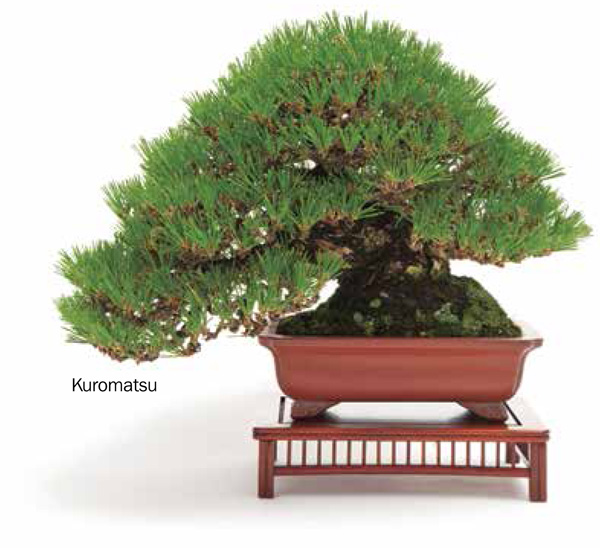 Zouki Trees ranging from broad-leaved deciduous trees, such as Momiji, Keyaki and Ichou, to broad-leaved evergreens such as Kuchinashi and Isozanshou, are called Zouki.
Zouki Trees ranging from broad-leaved deciduous trees, such as Momiji, Keyaki and Ichou, to broad-leaved evergreens such as Kuchinashi and Isozanshou, are called Zouki. 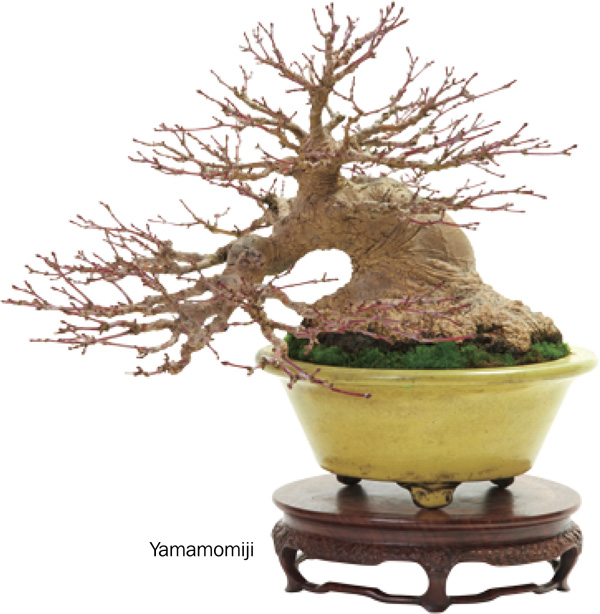 Hanamono Tsubaki, Ume, Sakura, Satsuki and other flower-producing trees are called Hanamono.
Hanamono Tsubaki, Ume, Sakura, Satsuki and other flower-producing trees are called Hanamono.  Hanamono Tsubaki, Ume, Sakura, Satsuki and other flower-producing trees are called Hanamono.
Hanamono Tsubaki, Ume, Sakura, Satsuki and other flower-producing trees are called Hanamono.
They require special care in the pruning of the flower sprouts. 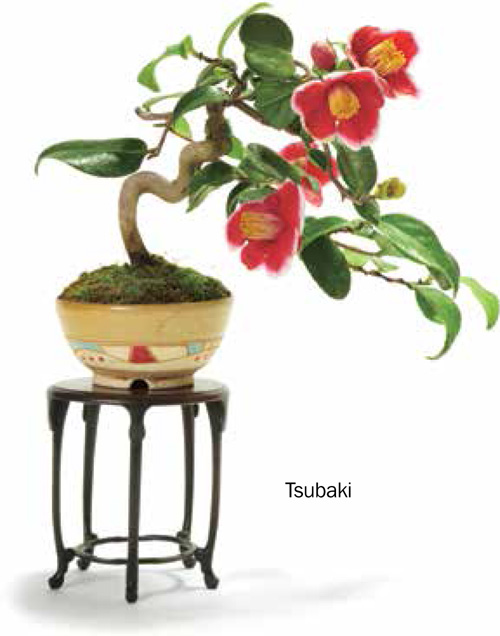 Mimono Species that produce fruits, such as Rouyagaki. Akebi, Karin and so on, are called Mimono. Each tree species follows a different breeding process.
Mimono Species that produce fruits, such as Rouyagaki. Akebi, Karin and so on, are called Mimono. Each tree species follows a different breeding process.  Kusamono Trees that produce grass, such as Daimonjisou, Sumire and Yukinoshita, are called Kusamono.
Kusamono Trees that produce grass, such as Daimonjisou, Sumire and Yukinoshita, are called Kusamono. 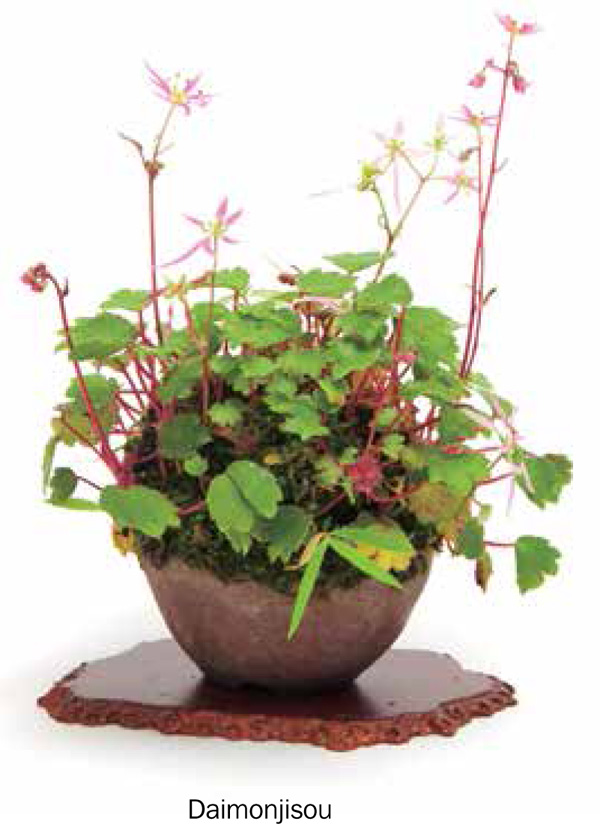 TREE SHAPES Tree shapes are chosen well in advance in order to be formed perfectly over time.
TREE SHAPES Tree shapes are chosen well in advance in order to be formed perfectly over time.  TREE SHAPES Tree shapes are chosen well in advance in order to be formed perfectly over time.
TREE SHAPES Tree shapes are chosen well in advance in order to be formed perfectly over time.
By knowing all the different shapes, youll have a better sense of what works, and can plan how to shape your tree accordingly.
Next page
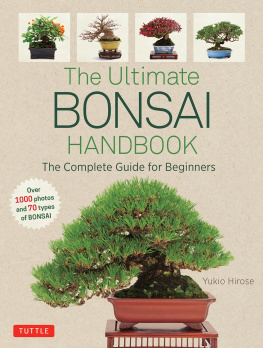


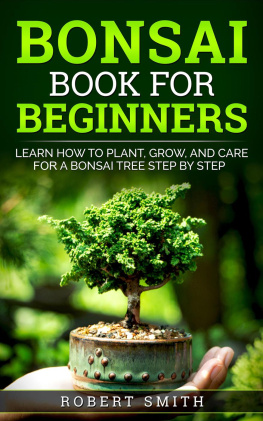
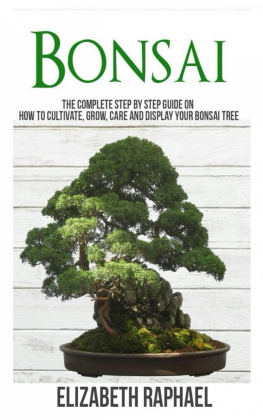
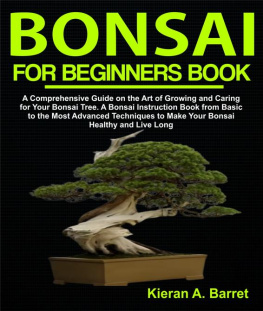
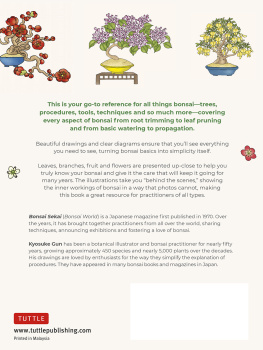
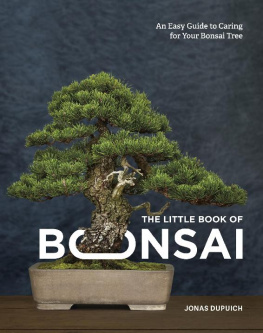
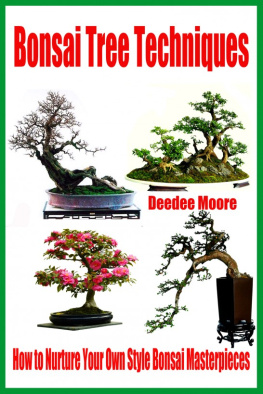
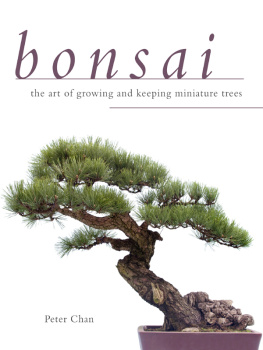

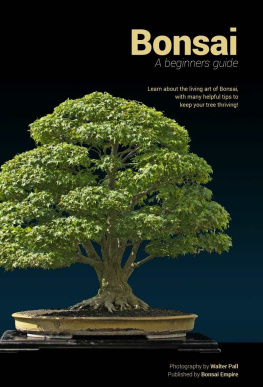
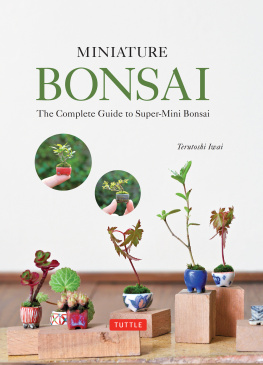
 The Ultimate BONSAI HANDBOOK The Complete Guide for Beginners Yukio Hirose
The Ultimate BONSAI HANDBOOK The Complete Guide for Beginners Yukio Hirose 
 INTRODUCTION Bonsai is a part of Japanese culture that has long been in the worlds spotlight. I discovered bonsai when I was a junior in college. After finishing up a karate training workshop in Kochi Prefecture, I headed over to the Osaka World Expo (1970). When I first laid eyes on authentic bonsai, I was moved by their beauty and decided then and there to make bonsai my career. My family already had a nursery and a decent landscape at home, so while I was helping out with the family business, I was fostering bonsai. Eventually, I started selling bonsai as well.
INTRODUCTION Bonsai is a part of Japanese culture that has long been in the worlds spotlight. I discovered bonsai when I was a junior in college. After finishing up a karate training workshop in Kochi Prefecture, I headed over to the Osaka World Expo (1970). When I first laid eyes on authentic bonsai, I was moved by their beauty and decided then and there to make bonsai my career. My family already had a nursery and a decent landscape at home, so while I was helping out with the family business, I was fostering bonsai. Eventually, I started selling bonsai as well. CHAPTER 1 THE BASICS
CHAPTER 1 THE BASICS  DIFFERENCES BETWEEN BONSAI AND GARDENING Even though the same plant can be used in both container garderning and bonsai, the goal, technique, container and result will be different. In bonsai, the role of the pot is perhaps more complex than it is for container gardening. The pot is shallow and must harmonize with the plants gender attributes. The pots size should be proportionate to the trees height, trunk width, root system and foliage.
DIFFERENCES BETWEEN BONSAI AND GARDENING Even though the same plant can be used in both container garderning and bonsai, the goal, technique, container and result will be different. In bonsai, the role of the pot is perhaps more complex than it is for container gardening. The pot is shallow and must harmonize with the plants gender attributes. The pots size should be proportionate to the trees height, trunk width, root system and foliage.
 MEMO Bonsai are classified by the height of the tree Large-size (also called Imperial) bonsai if the height is taller than 23 in (60 cm).
MEMO Bonsai are classified by the height of the tree Large-size (also called Imperial) bonsai if the height is taller than 23 in (60 cm).  WHAT TO OBSERVE IN A BONSAI The following tips can help you better observe and appreciate bonsai. Your first look should be up close; then, slowly distance yourself from the tree until you can see it in its entirety and context.
WHAT TO OBSERVE IN A BONSAI The following tips can help you better observe and appreciate bonsai. Your first look should be up close; then, slowly distance yourself from the tree until you can see it in its entirety and context. TYPES OF BONSAI Among the types of bonsai, other than Shouhaku, Zouki, Hanamono and Mimono, there are also Kusamono, which are planted alongside other bonsai. Shouhaku Starting from Matsu, Zugi, Hinoki and other evergreen coniferous trees are called Shohaku. Overflowing with life energy, they have the charm that comes with longevity, surfaces that attest to many years of living. Among them, Matsu are often used as New Year decorations, due to their color, which is said to bring luck (pictured here is a KuromatsuBlack pine).
TYPES OF BONSAI Among the types of bonsai, other than Shouhaku, Zouki, Hanamono and Mimono, there are also Kusamono, which are planted alongside other bonsai. Shouhaku Starting from Matsu, Zugi, Hinoki and other evergreen coniferous trees are called Shohaku. Overflowing with life energy, they have the charm that comes with longevity, surfaces that attest to many years of living. Among them, Matsu are often used as New Year decorations, due to their color, which is said to bring luck (pictured here is a KuromatsuBlack pine).  Zouki Trees ranging from broad-leaved deciduous trees, such as Momiji, Keyaki and Ichou, to broad-leaved evergreens such as Kuchinashi and Isozanshou, are called Zouki.
Zouki Trees ranging from broad-leaved deciduous trees, such as Momiji, Keyaki and Ichou, to broad-leaved evergreens such as Kuchinashi and Isozanshou, are called Zouki.  Hanamono Tsubaki, Ume, Sakura, Satsuki and other flower-producing trees are called Hanamono.
Hanamono Tsubaki, Ume, Sakura, Satsuki and other flower-producing trees are called Hanamono.  Mimono Species that produce fruits, such as Rouyagaki. Akebi, Karin and so on, are called Mimono. Each tree species follows a different breeding process.
Mimono Species that produce fruits, such as Rouyagaki. Akebi, Karin and so on, are called Mimono. Each tree species follows a different breeding process.  Kusamono Trees that produce grass, such as Daimonjisou, Sumire and Yukinoshita, are called Kusamono.
Kusamono Trees that produce grass, such as Daimonjisou, Sumire and Yukinoshita, are called Kusamono.  TREE SHAPES Tree shapes are chosen well in advance in order to be formed perfectly over time.
TREE SHAPES Tree shapes are chosen well in advance in order to be formed perfectly over time.